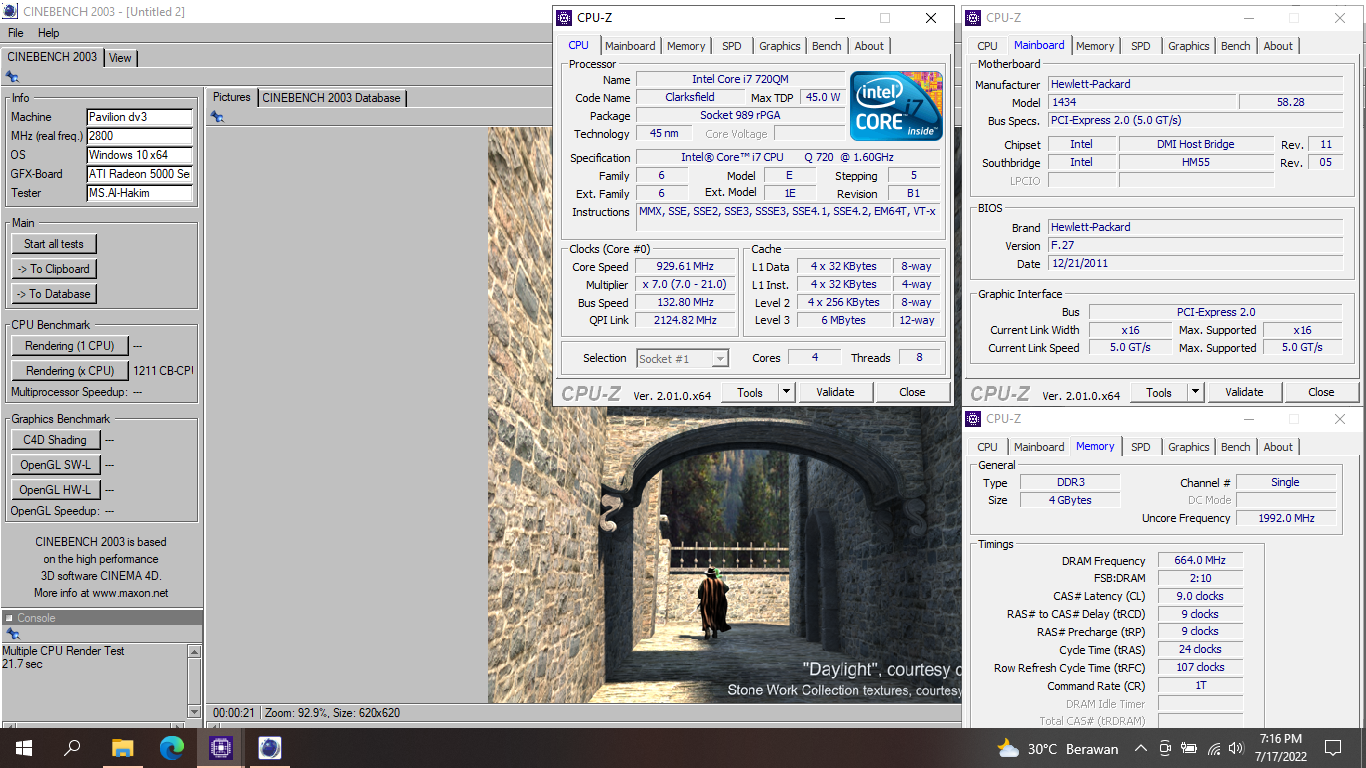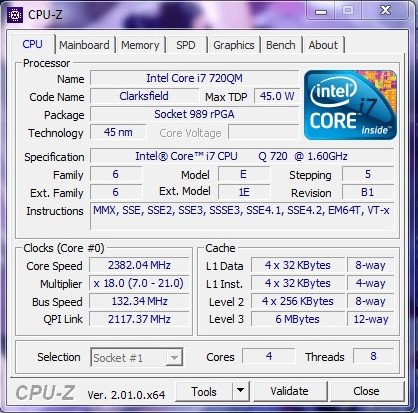Cinebench - 2003 score 1211 cb with a i7-720QM
Thursday, 01 January 1970 07:00 | Update at null
Media Gallery
Screenshot

Device, Setup, etc



URL
https://hwbot.org/submission/5042739https://www.facebook.com/hakimnu.id/posts/3336497563249550
Information Detail
Hardware: Intel Core i7 720QM
Specs:CPUID : Intel(R) Core(TM) i7 CPU Q 720 @ 1.60GHz
Architecture : x86
Codename : Clarksfield
L3 Cache : 6MB
Clock : 1.60GHz - 2.80GHz
Core/Thread : 4/8
TDP : 45W
Technology : 45nm
Socket : PGA988
IGPU : -
See more specification...
Software: Cinebench - 2003
Score: 1211 cb
About: Cinebench - 2003Cinebench 2003 is one of the early versions of the Cinebench suite of benchmark tools based on CINEMA 4D Release 8 software, a professional 3D application from MAXON. Although it's relatively old, Cinebench 2003 is still used by some tech enthusiasts and overclockers as a historical performance reference and comparison of processor architectures over time. The application is available for free and is compatible with both Windows and Mac OS operating systems.
This benchmark tests system performance through several rendering and graphics processing scenarios. The main test in Cinebench 2003 involves rendering 3D scenes using the CPU, which can measure the efficiency and computing power of up to 16 processor cores in a single system. The results are measured in the form of a score-the higher the score, the faster the processor completes the render job. This is very useful for evaluating the multi-core capabilities of CPUs, especially on early generation processors that are starting to support multiple cores.
In addition to CPU testing, Cinebench 2003 also includes an OpenGL-based graphics test, where thousands of animated polygons are rendered in real-time to assess the GPU's ability to handle complex graphical displays. This test is important for users who want to understand how their system handles viewport-based graphics workloads, such as those often found in 3D design and modeling software.
Although it has been replaced by more modern Cinebench versions such as R15, R20, and R23, Cinebench 2003 still has historical and technical value. Many benchmark data collectors and retro hardware enthusiasts use this version to consistently test and compare the performance of older systems. With a long track record of use and transparent testing methods, Cinebench 2003 is still relevant as a reference tool to see the evolution of CPU and GPU performance over time.
The Intel Core i7-720QM, launched in Q3 2009, was one of the first mobile quad-core processors to feature Intel's Nehalem microarchitecture, specifically the Clarksfield variant. Targeted at high-performance laptops, such as gaming machines and mobile workstations, the i7-720QM brought 4 physical cores and 8 threads to the mobile platform, thanks to Hyper-Threading Technology providing a significant boost in multi-threaded workloads like video editing, 3D rendering, and other professional-grade applications. The processor runs at a base clock speed of 1.6 GHz, but it can dynamically increase up to 2.8 GHz using Intel Turbo Boost, depending on thermal headroom and power availability.
Manufactured using a 45nm process, the i7-720QM has a TDP of 45W, which is quite high by today's mobile CPU standards. This thermal demand necessitated more robust cooling solutions in laptops that featured the chip. Unlike modern CPUs, the i7-720QM does not come with integrated graphics, which means systems based on this processor require a dedicated GPU often from AMD or NVIDIA for graphics processing and display output. As such, it was typically paired with mid-to-high-end discrete graphics cards in its time, making it a solid choice for gaming and multimedia laptops in the late 2000s and early 2010s.
While the Core i7-720QM was a powerhouse during its release, its performance and efficiency are significantly outpaced by modern CPUs built on smaller nodes and with higher IPC (Instructions Per Clock). Nevertheless, legacy laptops using the i7-720QM can still be viable for basic computing tasks like web browsing, document editing, or watching videos especially if paired with an SSD upgrade and increased RAM. Users running Windows 10 on such systems may experience some limitations, but with proper optimization and lightweight software, the CPU can still deliver a usable experience in non-demanding environments.
Hardware Detail:
Device: HP Pavilion dv3-4054TX
RAM: 4GB DDR3 Single Channel
OS: Windows 7, Windows 10
* Not Avaiable
